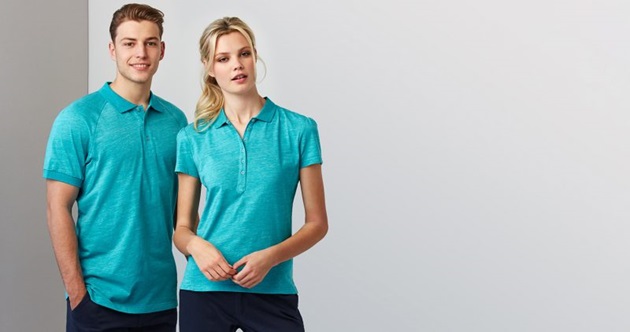Modern Business Shirts: Add Style and Comfort to Your Company’s Dress Code
There are many reasons why uniforms are a common practice in various industries, including healthcare and hospitality. They create a professional appearance, promote brand awareness, ensure safety, maintain hygiene, and make a sense of equality among employees. They also result in cost savings by eliminating employees needing to purchase work attire.
Uniforms also improve customer service by instilling professionalism and authority. Furthermore, uniforms foster team building, fostering collaboration and cooperation among employees. Overall, uniforms are a valuable asset for businesses, benefiting employees and the company.
Whether you’re a new opening business designing your first uniform, rebranding or re-considering your existing one, choosing dress code staples, like a modern business shirt, can make the process much easier.
How to Design Corporate Uniforms?

According to studies, the vast majority of individuals enjoy dressing for work. Yet many would rather not wear uniforms. A lot of people have strong feelings against uniformity. And some become quickly bored if they have to wear the same clothing over and over again. So, how can you design a uniform that your employees will love?
There are many factors to consider when creating your corporate uniform. Yet, when you include modern pieces like extra-comfy and sleek corporate shirts, it helps your employees look professional, stand out from the crowd and feel pleasant and unique. They also give room for personalisation and embroidery.
The shirt has always been an essential part of many business outfits. It’s unquestionably a piece of clothing that shows class and professionalism, drawing attention to the person wearing it and the company’s values. You can wear this clothing staple to the office, important business meetings, or a business lunch with a client.
What to Consider when Picking Corporate Shirts?
The fabric, collar and button style, as well as its wearability and cuff shape, are the most crucial considerations for finding the correct shirt for your staff. Depending on the industry and your specific needs, you may want to have a look at several other factors that can determine the final shirt choice.
Fabrics and Styles
Both natural and synthetic fibres are used to make corporate shirts. Cotton is one of the most popular because it feels soft and clean. Some manufacturers use 100% premium cotton shirting fabrics, produced in line with one of the world’s best-known textile standards, without harmful substances, which is good news for you and your crews!
Another typical fibre is polyester, which is antibacterial, breathable, and stretchy to enable you to move freely. The Cotton-polyester blend has the best qualities of both worlds. Its goal is to keep its shape and colour even after being washed many times. But most importantly, it makes you feel comfortable in both summer and winter.
Besides the fibres, the weave is also critical because it can immensely impact the style of the shirt. For example, cotton popline is a strong fabric that is light and suitable for any event. Twill, on the other hand, is a bright fabric that is great for semi-formal events because of its weave. If you want your crew to look more casual, you should go for Oxford shirts, which, besides being very soft and durable, are appropriate for a formal or informal setting.
Shirt Collars for Every Look

When choosing the correct shirt for your company’s uniform, it’s necessary to be careful because it’s one of the shirt’s most noticeable and intriguing parts. “Point spread,” or the space between the pointy ends of the collar leaves, is the main difference.
An option for a classic look is the Italian collar. It’s slightly tight and works best for people who want to wear a tie with their shirt. The long, pointy ends of the collar stand out. The so-called French collar is broader, and the points are shorter and less noticeable, making their distance stand out more. It gives off an air of being modern and young.
As for women’s shirts, you can find many different collar types made over the last few hundred years. Take the Peter Pan collar as an example. Its smooth shape follows the line of the neck and gives off an elegant vibe.
What people in Italy call a ribbon collar (also called a “Pussycat bow neck” in English) is made up of a cloth tie that can be tied or knotted. That’s a creative way to dress up a business shirt while keeping it professional.
The Difference-making Cuff
The cuffs are what make a shirt look classy. In general, they should fit the collar and be picked out based on the style of the shirt. One example is the barrel cuff; it has rounded sides held on by a single button. It gives the dress a new, soft look in a formal setting. The square cuff, on the other hand, goes with a business casual outfit.
The Mitered cuff, described in this way for corners that are 45° in shape, can be the middle ground between the other cuffs. People like how flexible it is: it can be used in a more formal setting or during a typical workday and goes fantastic with a statement-making wristwatch.
If your goal is to amaze, you must veer on a visually outstanding decision. There are no buttons on the French cuff, but there are buttonholes. This style is acceptable for business events like a gala dinner or an awards show, especially if you wear cufflinks.
Picking Buttons
The button is an incredibly adaptable fashion accessory; it may be either a classic and understated piece or a modern and sophisticated one by matching or contrasting its colour with the cloth.
Some buttons are subtle, while others, like those with a reflective surface, demand attention. Selecting the best ones is challenging; material, size, and design are all factors to consider when selecting buttons.
The first decision is the material, which may be plastic, wood, enamelled metal, or natural mother-of-pearl, depending on the desired look. Buttons come in various sizes, the most common being 11mm to 20mm in diameter and 2mm to 3mm in thickness. You can express more character by using larger buttons.